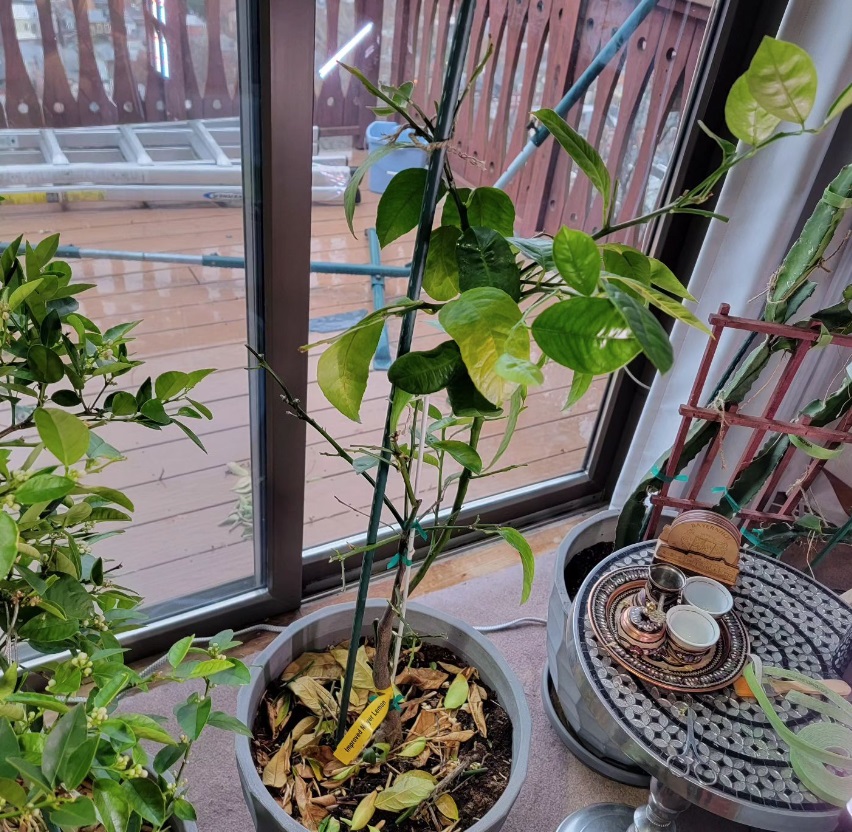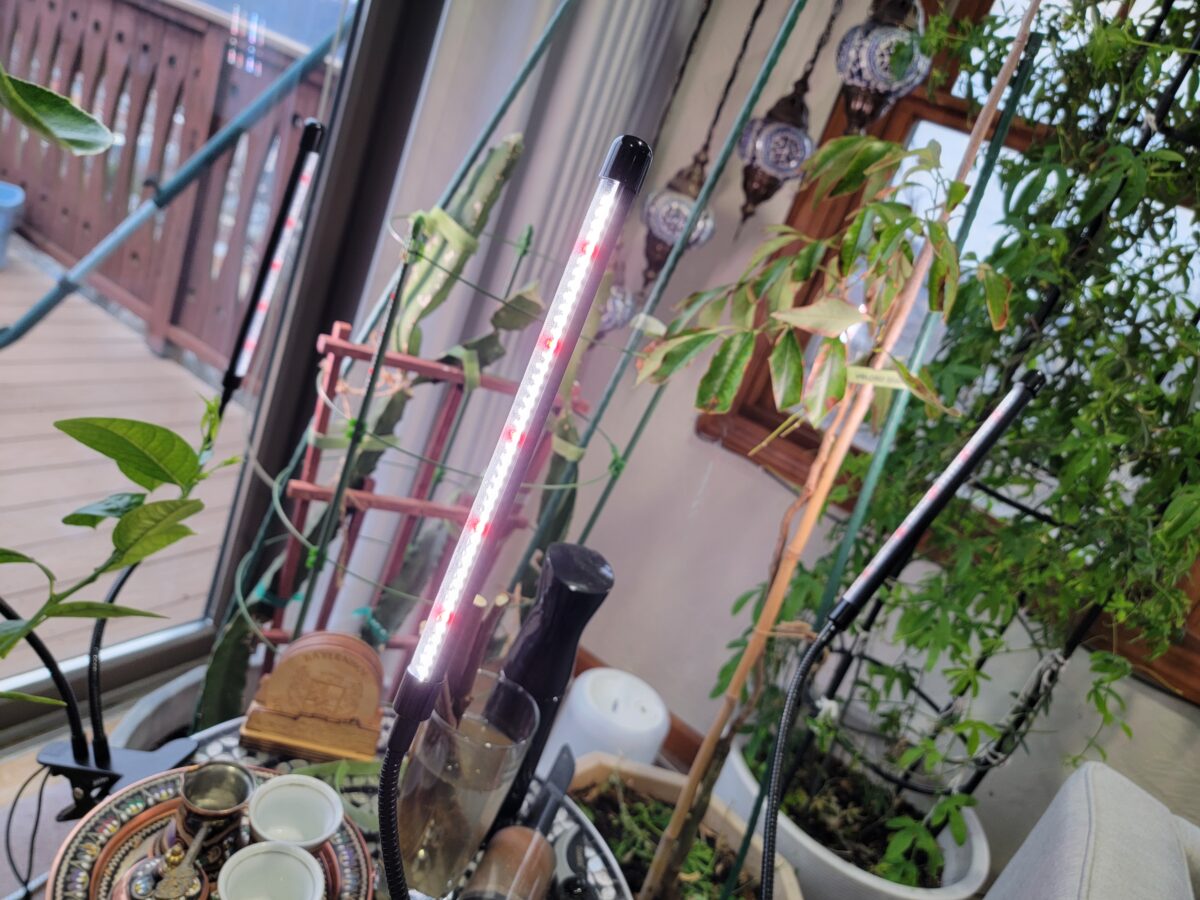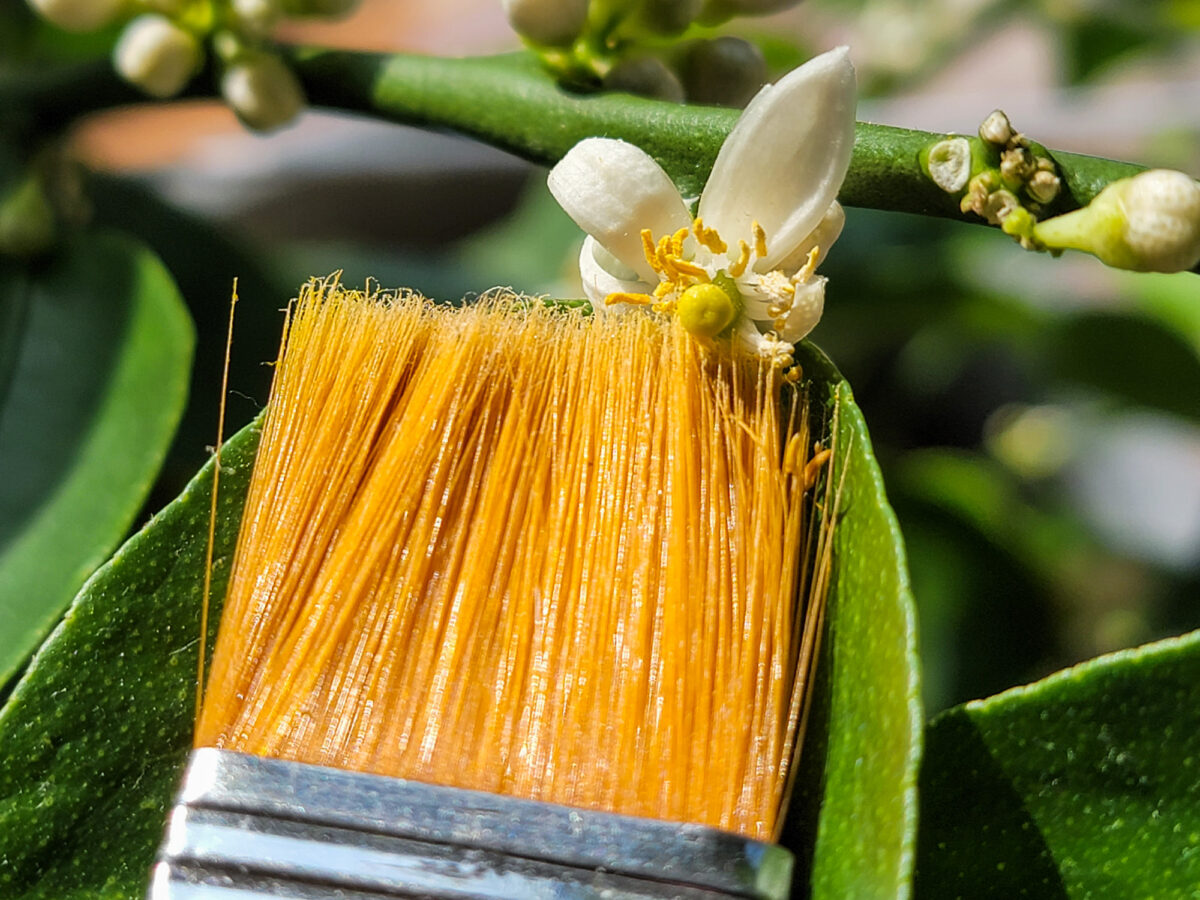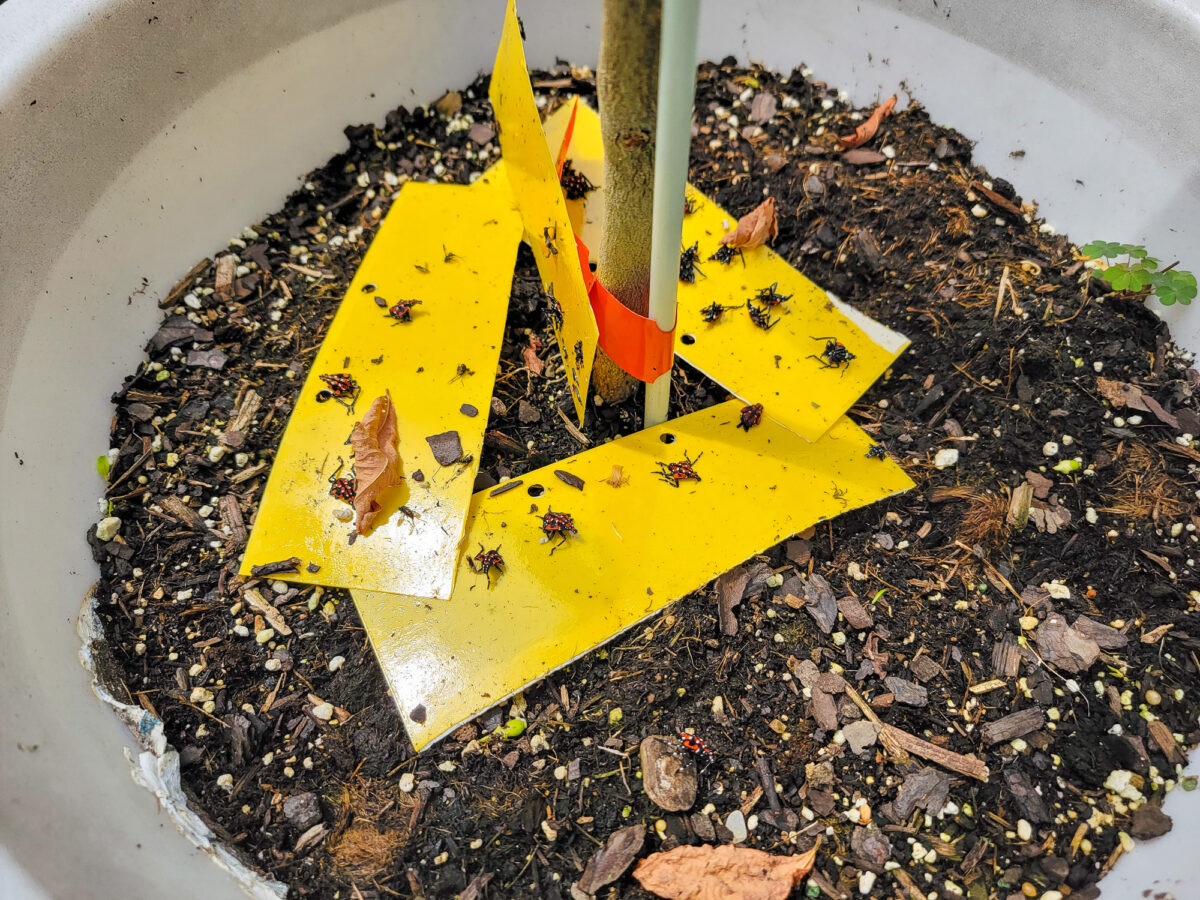Disclaimers: Our site uses demographic data, email opt-ins, display advertising, and affiliate links. Please check out our Terms and Conditions for more information.
If you live in a cooler climate, as we do in zone 6b/7, odds are good you'll have to bring some container plants inside for winter.
We love growing tropical fruit trees, and, as you can expect, they do not do very well outside when temperatures drop close to freezing (let alone as low as 0 °F that we sometimes see in extreme cases). As such, we bring our plants inside for the winter to help give them an environment that they can tolerate until the following spring when temperatures rise once again.
But there are some things you will likely experience when doing this, and after several seasons with our own citrus trees, we have some thoughts that you should know before heading into winter!
Your Tree Will Likely Lose Leaves
One of the first things that will likely happen when bringing container plants inside for winter is that they will likely lose some of their leaves- even if they are not supposed to have leaf drop.
Don't panic.
The simple explanation is that when a plant comes inside for winter, it experiences a shock as it adjusts to its new environment. Elements like watering, light, heat, and humidity will change drastically with a move, and a tree losing its leaves is a coping mechanism in most cases.
Fewer leaves mean fewer resources must be extracted from the soil, less water loss through evapotranspiration, and so on. This is often why watering and fertilizing frequencies drop when plants are brought indoors- their needs are likely going to be reduced considerably from what it was utilizing outdoors.
After some time, generally on the order of weeks or a month or so, your plants will get into a new equilibrium, adjust to their new home, and start sending out new vegetative growth if conditions are adequate.
That said, the degree of leaf loss could be a sign of bigger problems if your tree is losing almost all of its leaves over a fractional amount. Extensive leaf loss could be a sign that your plant is not receiving a minimum set of conditions, and we'll talk more about those in subsequent sections of this article.
- Note: Some trees go fully dormant in winter and lose all of their leaves (e.g. figs). It is important to research and see if your tree is meant to lose all of its leaves or not during winter before determining if you should be concerned.
- One year our lemon tree lost more leaves than we thought it should, and we realized that there was rootstock growth competing with the grafted tree. This is just one of many possible issues that could also contribute to leaf drop beyond the change in growing conditions.
Maintain Proper Lighting
So now that you are prepped for your tree to be in for a bit of shock coming inside, what should you do to help it thrive?
Up first, we have lighting. All plants have their ideal lighting level, and if your plant was previously outside, it was likely a partial-to-full sun kind of plant. As such, you'll do well to find a place in your house that provides similar partial-to-full sun conditions!
For most plants, especially tropical plants like the ones we personally grow, we generally put our plants near windows that face south or southwest to maximize how much sun they receive throughout the day. Full sun plants have prime placements, partial sun plants get the second-best spots, and so on.
A perk of these particular window placements, for us at least, is that in the winter, the sun is fairly low on the horizon at our home, and we have ample spaces in our south-facing house to provide 6-8+ hours of lighting to our plants- often the bare minimum needed for tropical varieties.
How much sun you can naturally provide your plants will be highly dependent on your specific location, house orientation, and window setup. If you cannot provide the minimum level of lighting a plant needs, odds are good you'll want to supplement with grow lights to get you to the rest of the way.
Even with our abundant natural light, we still supplement with grow lights to provide ideal conditions, especially on cloudy winter days when the sun is reduced.
Be Aware of Watering and Humidity Concerns
As mentioned above, odds are good your watering frequency will change when you bring a plant indoors simply because the plant will dry out slower and retain more water in cool conditions.
Where a tropical plant may require a good dousing of water a couple of times a week when outdoors in a hot environment, you may find a cool environment indoors may reduce your watering frequency and volume considerably.
In this instance, it is all about monitoring how wet the soil is and only watering enough based on the plant's needs- not having it sitting in water in a drip tray in conditions that could allow for root rot. There is no rule of thumb here that could apply to every plant, so you will need to read about your own plant's specific needs and adjust based on real-time observation over days and weeks.
Likewise, plants will also experience a change in humidity when brought inside, with most buildings with air conditioning being a little less humid than outdoor conditions. As such, some plants may also do well with a humidifier running for a few hours each day and a handheld mister to provide localized water to the leaves to prevent them from drying out, too.
Again, these are things you will only learn through observation. Being too aggressive with raising humidity or spraying leaves with water can also create conditions where fungus and rot can set in, so understanding what your plants prefer is a bit of a learning curve.
Hand Pollinate Any Flowers
There is another element of keeping a plant inside during winter that you need to be aware of, particularly if it is a fruiting tree, bush, or cactus- pollination!
For most plants, an external mechanism is required for a flower to pollinate. Whether that is wind blowing pollen from one tree to the next, a bee or insect moving pollen around, or another factor entirely, the same end result has to happen- pollen has to be moved from the stamen to the stigma to complete fertilization.
When indoors, the external mechanisms become much more limited, and most plants rely on us to hand pollinate to complete the final step.
How easy it is to move pollen from the stamen to stigma for any given plant can vary.
For small flowers, you may be able to simply move the stamen to touch the stigma or use a small tool like a paintbrush or cotton swab to collect pollen and then touch the stigma. For larger flowers, an external device like these could also work, or you may even be able to pinch off a piece of the stamen and use that to move around and lightly touch nearby stigma (we do this on our passionflowers, for example).
In either case, if you are growing fruit trees, bring them indoors, and they begin to flower, you will need to make sure you hand pollinate to reap the rewards of fruit!
- Note: Many plants often flower when stressed for nutrients or water. If the plant senses that it could be dying, flowering is a last-ditch attempt to carry on by fruiting, seeding, and growing another plant. This happens to our citrus trees every year when we bring them indoors after they lose a flush of leaves. That said, as plants cope to their new indoor conditions, we also experience a great deal of flower drop if the plant is too water stressed- so our yield of fruit in winter is often limited.
Pests Come Inside With the Plant
One issue that creeps up on us year after year when we bring our plants inside is an uptick of pests found on the plant- particularly spider mites (on the leaves), aphids (on the leaves), and fungus gnats (in the dirt).
There are many theories as to why you'll see an uptick of pests in the winter, and to us, the one that makes the most sense is that indoor conditions are simply ideal for pests to exist and reproduce.
Fungus gnats tend to reproduce in wet soils, as dry soils are inhospitable for them. When are your soils often more wet? When they come indoors. Spider mites and aphids can get sprayed off trees with a robust soaking of water, and what do you not have when inside? Heavy rain. The stars align for pests for many reasons when bringing a plant indoors.
As such, our recommendations here are twofold.
First, preventative measures go a long way before you bring your plants inside for winter. If you are okay treating your plants, you may want to apply a layer of food grade diatomaceous earth on the soil for a few days (when dry) to help kill off any soil-bound pests and spray all of the leaves of your plant with an insecticide like neem oil.
Diatomaceous earth is made up of diatoms, tiny organisms whose remains are comprised mostly of silica. This dry powder cuts open the skin of pests that walk on it and leeches out moisture, causing them to die out while generally being safe for your plant at large. The only kicker here is that your plant must be quite dry to apply, as any soil moisture will get wicked up into it and cause the silica to lose its effectiveness.
Neem oil is a natural herb extract that can be sprayed on bugs, which helps kill them on contact, lowers their reproduction, or simply displaces them from the tree when sprayed via a pump sprayer due to the pressure applied. Much like diatomaceous earth, Neem is considered non-toxic to plants and fruits as well.
Second, as with most all pest deterrents, it is impossible to say anything is 100% effective. A liberal covering of diatomaceous earth will knock the soil-bound pest population down, but it may not eliminate it. Likewise, neem oil may need a few rounds of applications and still not be 100% effective.
What does this mean? Simply put, even with some preventative treatment, the pest population on your trees could rise over time. You may need to pull out some sticky traps around the dirt of your citrus tree to capture flying gnats, or if the weather is nice, take the tree outside for an application of Neem or another dousing of diatomaceous earth if the pest population starts to rise over time.
Still, a bit of preventative treatment before bringing your plants indoors can protect their health over winter, so read a bit more about recommendations for your specific plant and plan accordingly!
- Note: Diatomaceous earth is a super fine powder that will blow more or less everywhere with even the slightest bit of airflow. As the particle is quite small, there are some possible health concerns if inhaled in large enough quantities. As such, this is one reason why we like to avoid applying it when indoors.
Survival is The Most Important Part
Ultimately, unless you have a plant that only flowers and/or fruits in winter, the name of the game when moving plants indoors is simply survival.
If your plant needs warm, outdoor conditions to thrive, anything you provide indoors may only be a stopgap to hold it over to the next season.
Your plant may struggle. It may get a setback. You may have to hold its hand and keep an eye on it. Ultimately, new growth and successful flowering/fruiting are positive things to come while being inside during winter, but they aren't the main goal.
Survival is.
If all you do is manage to get your plant to hold on until spring when it can head back outside and into the conditions it prefers, well, sometimes that is good enough!
Do you have any other survival tips to help your plants make it through a winter indoors? Comment below to share!




